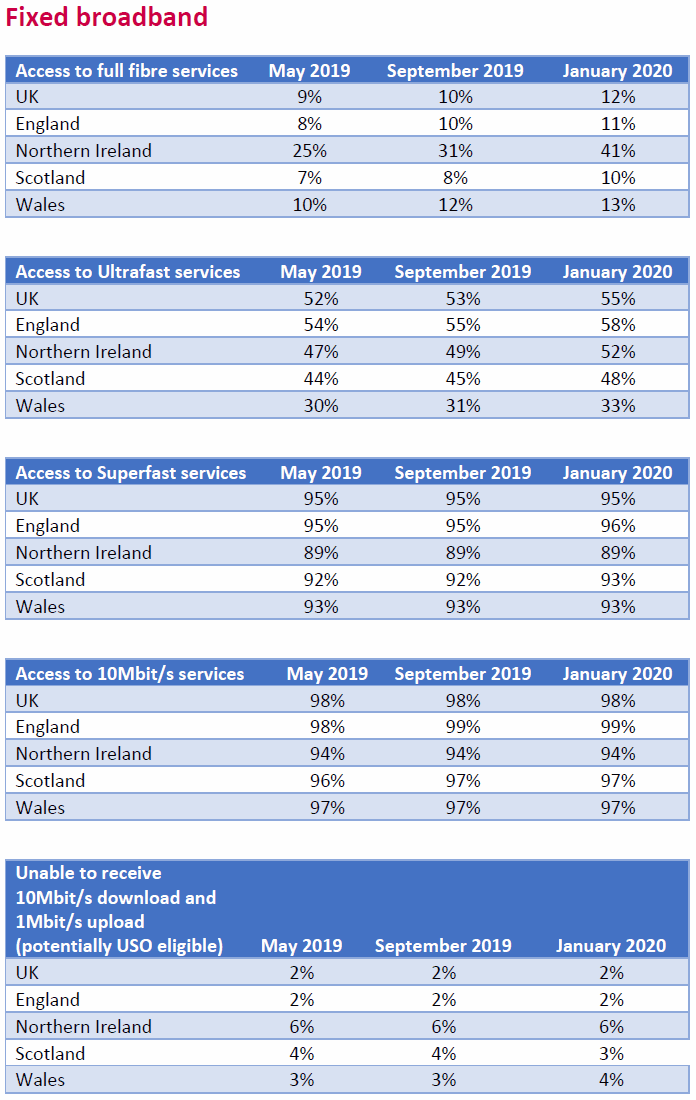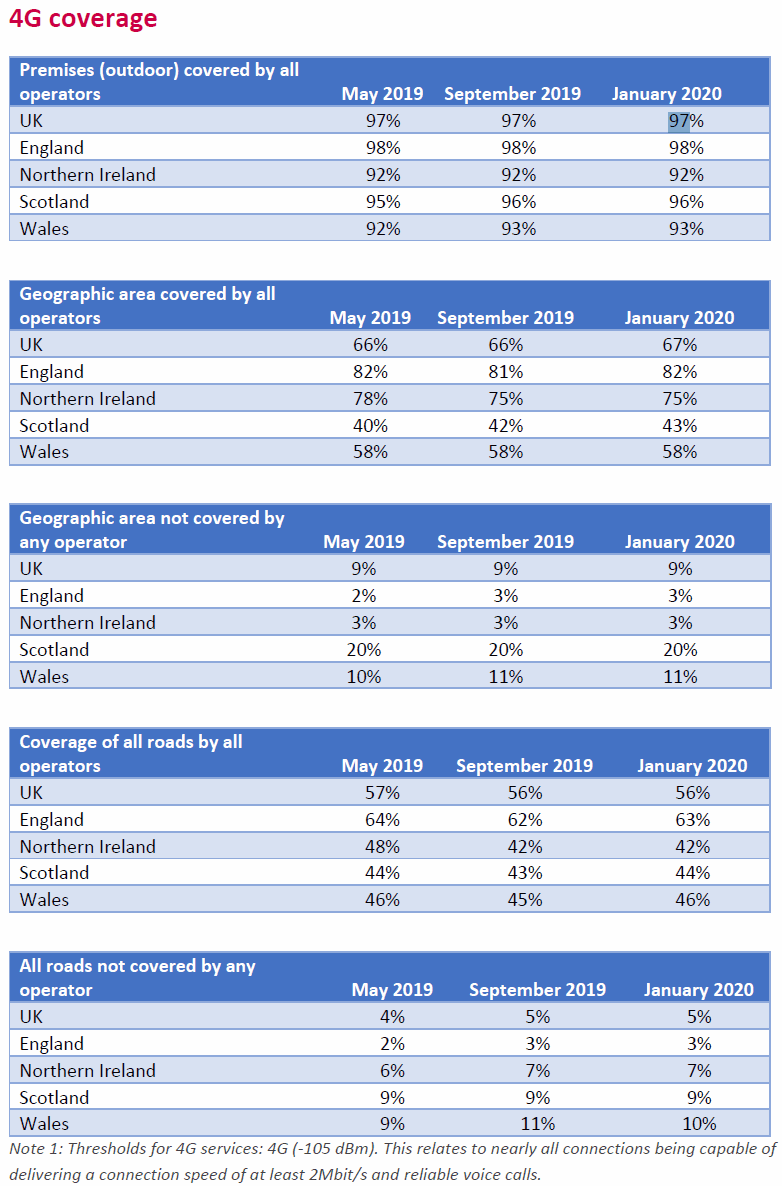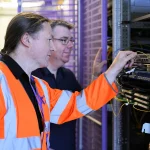Ofcom – Full Fibre Broadband Grows to 3.5Million UK Premises

Ofcom has published their Spring 2020 update for UK broadband and mobile networks, which reveals that “full fibre” (FTTP) coverage has risen to 12% (up from 10% in September 2019) and the number of premises unable to get 10Mbps+ remains at 2% (608,000 premises). Geographic 4G coverage is now 67% (up from 66%).
Crucially we should point out that today’s report is actually based on coverage and service availability information received from ISPs and mobile network operators as of January 2020, which is thus four months more current than the September 2019 data in their previous update (here).
Otherwise, “ultrafast broadband” availability (defined by the regulator as 300Mbps+) has increased from 53% to 55% of UK homes and businesses since the last update, while “superfast broadband” (30Mbps+) coverage remains unchanged on 95%. On top of that it’s noted how 3.5 million (12%) premises can now order a Gigabit capable Fibre-to-the-Premises (FTTP) service, which is up from 3m in the last update.
Advertisement
At present most of the growth in ultrafast connectivity comes from the expansion of Virgin Media’s hybrid cable and full fibre network, although Openreach has also been deploying both G.fast and FTTP technology. Similarly lots of alternative network ISPs are helping to spread FTTP at an increasingly rapid pace (Summary of Full Fibre Builds), with Cityfibre and Hyperoptic being two of the biggest movers.
We should add that Virgin Media’s upgrade to DOCSIS 3.1 technology has also made their network capable of 1Gbps+ speeds and future 5G fixed wireless networks may be able to achieve the same, provided enough spectrum and capacity exists to support them.
The improved fixed line broadband coverage also means the number of premises that cannot get a “decent broadband” (10Mbps+) service is just 2% or 608,000 (almost unchanged from 610,000 in the last update). A download speed of at least 10Mbps and an upload of 1Mbps also represents the specification for the UK Government’s imminent broadband Universal Service Obligation (USO), which began in March 2020.
Take note that if we include 4G into the mix for USO delivery then the gap drops from 608,000 to just 189,000 premises. Speaking of which, 4G mobile networks have seen outdoor coverage by all operators (EE, Three UK, O2 and Vodafone combined) hold steady at 97%, while geographic coverage from all operators is 67% (up from 66%) over the same period.
Advertisement
January 2020 Coverage Data by Region
The following table summarises the latest mobile and fixed broadband coverage figures for Scotland, Wales, England and Northern Ireland individually and you can get more detail by downloading the full Spring 2020 Update (PDF).


Mark is a professional technology writer, IT consultant and computer engineer from Dorset (England), he also founded ISPreview in 1999 and enjoys analysing the latest telecoms and broadband developments. Find me on X (Twitter), Mastodon, Facebook, BlueSky, Threads.net and Linkedin.
« Ofcom 2020 Study – Average UK Broadband ISP Speeds Hit 64Mb






















































Only 12% fibre coverage in this country? That’s a sad picture, shows this country is many years behind of where it should be. Also, why aren’t the final 2% being addressed here? How on earth did they ever manage to install phone services in the rural areas in the first place? Is it really so hard to do it again, this time with fibre? Especially since the poles and ducts are mostly there!
Its not difficult, mostly, its the sheer cost.
The final 2% aren’t being addressed because they can make a better return on investment by upgrading urban areas that already have FTTC or other superfast options as that is where the population density is (which is why they already have superfast). They can justify ignoring those 2% because we now have the USO, so those without a “decent” broadband option can in theory request one.
However, the reality is that most can’t get a USO option as the checker thinks they already have one – e.g. the USO checker says I can already get 10Mbps, but BT give an estimated speed range of 5-11Mbps with a guarantee of 3Mbps. As I only recently cancelled ADSL2+, I know that the upload did not meet USO.
Rural phone lines (and water and electricity) were delivered a) using government funding and b) Universal Service Obligations.Even with those two things, gas and sewers never reached ubiquity.
The utilities are no longer government owned which discounts option a unless you create something like BDUK. The USO option is also difficult in a competitive market.
The b option – USO relies on customers in dense urban areas paying more than their relatively low cost of provision to subsidise customers in the more expensive to reach rural areas. Socialisation of risk, or national cost averaging if you prefer. In a competitive market though, the USO makes the provider more expensive in urban areas than competitors who don’t have rural offerings. If the cost difference means that your provider loses customers to cheaper operators, there’s not enough money to subsidise the rural ones any more.
In a competitive market the USO can only work if all the players contribute to the rural subsidy, as happens with electricity supply.
If rollout was easy and cheap, there would be more rural competition to Openreach. There isn’t. Empirically, if it was easy it would be done – anyone can set up a telco and build some plant and begin to offer service. If demand exists and Openreach haven’t served it, but no-one else has either it draws you to the twin conclusions that it’s much harder to do than you apparently think, and that the cost of doing so makes a return for investors unlikely. Alternative providers can be vertically integrated and retain more of the customer’s monthly bill than Openreach so if anything it ought to be easier to make the numbers add up.
“anyone can set up a telco and build some plant and begin to offer service” – indeed, but IMO that is one of the problems. Quite a few have set up a telco, announced that they will build thousands of connections in an area thereby satisfying the market provision from BDUK’s point of view (or won a BDUK contract), but then nothing much has happened since.
@GNewton
“Also, why aren’t the final 2% being addressed here?”
You realise that the government announced £5bn of funding for such areas for the deployment of FTTP?
“the government announced £5bn of funding for such areas” – which is very welcome, but the regulatory structure for spending that won’t be in place until late 2021, and the earliest any builds funded by that cash are expected to start is 2023.
Worth saying, on the 2%, that the BDUK programme still has some active deployments (mostly of FTTP) in rural areas and the £200m RGC voucher scheme is also for rural areas. These are being used to keep the rural build going while the £5bn programme sorts itself out for contracts.
Yes, many BDUK builds are still underway. The build in my area (part of the Fastershire builds) is supposed to start this year- although there is currently no approved plan, no planned works, and no progress updates, so I expect yet another slip. I expect the time limit for BDUK projects will have to be extended as there is no possible way Gigaclear can complete the build by 2023.
@125us: “the USO can only work if all the players contribute to the rural subsidy, as happens with electricity supply.”
I fully agree with that.
Perhaps keeping vital utility-style infrastructures with private businesses is not a good idea.
The OFCOM 12% claim is misleading because that includes business/commercial users who sometimes buy fast fibre connections at huge cost. This figure is no indication of how many UK homes have a full fibre service. The FTTH Council Europe puts UK FTTH/B coverage for fibre to the home and building (blocks of flats) at no more than 2.8% as of September 2019. It beats Serbia and Austria but is way behind every other country in Europe. See FTTH Council Webinar April 23, 2020 (slide P17): https://www.ftthcouncil.eu/documents/FTTH%20Council%20Europe%20-%20Panorama%20at%20September%202019%20-%20Webinar%20Version4.pdf
Why is the UK takeup so low at 18.2% if so many want it?
Graham I think you may have confused different figures. The 12% from Ofcom is premises or homes passed, while the 2.8% from the FTTH Council Europe is market penetration based on subscribers.
https://www.ispreview.co.uk/index.php/2020/04/uk-creeps-up-2020-ftth-ultrafast-broadband-country-ranking.html
In fact the council stated 15.1% for coverage, which seems unrealistic for the September 2019 data set. According to TBB’s more recent figures, the UK is currently at 13.65% and that seems fair.
@The Facts. “Why is the UK takeup so low at 18.2% if so many want it?” This doesn’t make much sense, why should 18.2% be considered a low figure so early in the roll-out? That’s actually pretty good for young deployments.
“Why is the UK takeup so low at 18.2% if so many want it?”
If you think that this, or the fibre broadband deployment in the given areas, is bad or wrong, then say so! As Mark correctly explained, this is actually a promising takeup for a new service.
Of course, fibre should totally replace copper in the long term, which would eventually mean 100% takeup.
@GN – it’s very touching that you reply to me so quickly every time.
xxx
“Why is the UK takeup so low at 18.2% if so many want it?”
It’s a blended figure.
There are areas of FTTP coverage where the only alternative is low-speed ADSL; in those areas FTTP takeup is very high.
Then, there are other areas of FTTP where it sits alongside FTTC. Many people are very happy with 80/20 or 55/10 on FTTC, and don’t see the need to change to FTTP – which currently is offered by a much smaller choice of ISPs. Once Sky and Talktalk and Vodafone are selling Openreach FTTP, and actively moving users across, takeup will rise.
Mark, suggesting that the 12% properties passed is the correct measure rather than the 2.8% subscibers as measures by FTTH Council Europe is exactly the same as HMG claiming that have capacity for 120,000 Covid19 tests/day when in reality they rarely exceed 80,000/day. We know how easily HMG have massaged those figures by included tests mailed out but not yet returned, so you can expect the “properties passsed” (without subscribers connected) to be equally massaged by OFCOM to present the best possible impression without actually delivering a FTTH service to customers. ONLY actcual FTTH connections with customers at the end of the fibre should be counted and on that reasonable measure the UK REMAINS THE WORST COUNTRY IN EUROPE. Should we celebrate that the UK beats Serbia and Austria? I thnk not.
@Graham
Who’s “fault” is it that the occupants of the other 10% or so of premises passed by FTTP have chosen not to purchase services? It clearly isn’t the fault of the industry that has invested in provision and it would seem a little odd for a Parish Council Chair to, apparently, want to dictate how residents and businesses spend their money.
First you wrongly suggest that the numbers include leased lines (the tables are clearly titled *broadband*) and now you want to ignore service availability and instead count subscriptions. Perhaps you could better focus your attention somewhere else.
@TheFacts: As usual, yours was a bit of a silly question again. If you are a real poster, and you believe that there is only a small demand for fibre broadband, then say so, and back it up with some proper research.
For Graham Long
Sorry but Mark is right and you are wrong.
The 12% is premises passed
The 2.8 is premises connected
Two very different things, if you actually read the FTTH Council stuff their premises passed for UK was 15% – which looks wrong and probably down to how iDate is collecting data i.e. for the date they say data relates to it was around 5 percentage points too high.
Premises need to be passed first, then once connected you get an idea of how popular a service is and whether a provider has enough people available to do the final install into peoples homes and businesses.
Counting the two sets of figures is important and important as it costs money to pass premises and people need to know they are passed so they can order.
Ultimately the connected figure does become more important but you need that initial figure too.
I live in a busy commuter town in Hertfordshire and normally work in central London.
Due to lockdown I’ve been working from home and as I downloaded and upload a lot of videos for work I realise I have a really poor broadband. I’d like to improve it (download speeds are just over 1Mbps upload speeds are slightly less) but as we don’t have fibre optic my only option seems to be Virgin which I’m loathe to go with as had issues with poor customer service in the past. Any suggestions?
4g router if you get a signal.
You can apply for USO @ that speed.
https://www.bt.com/broadband/USO
If someone can get Virgin Media then they cannot get any USO help
According to OFCOM’s Customer Satisfaction Tracker 2019:
“Virgin Media (85%) customers have higher than average satisfaction with the speed of their broadband service, while TalkTalk customers satisfaction is lower (74%)”
My own experience is that the reliability of VM’s broadband and Pay TV is excellent but its CS can be atrocious. As broadband matters to you more than ever I suggest that you move to VM. Bear in mind that you have the right to cancel service without penalty within your 14-day cooling off period.
Thank you for your comments and advice. I think I will go with VM. As you say if I’m not happy within the first 14 days I can cancel